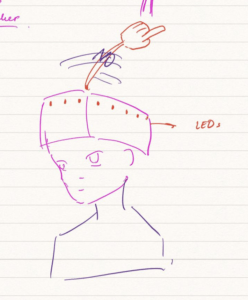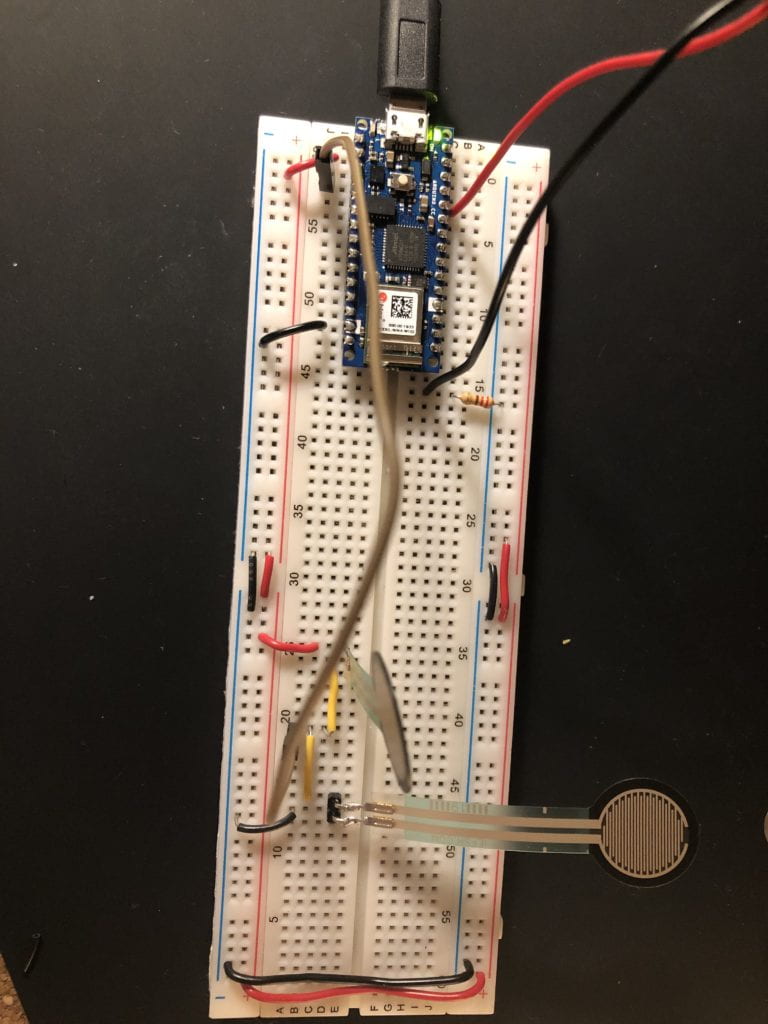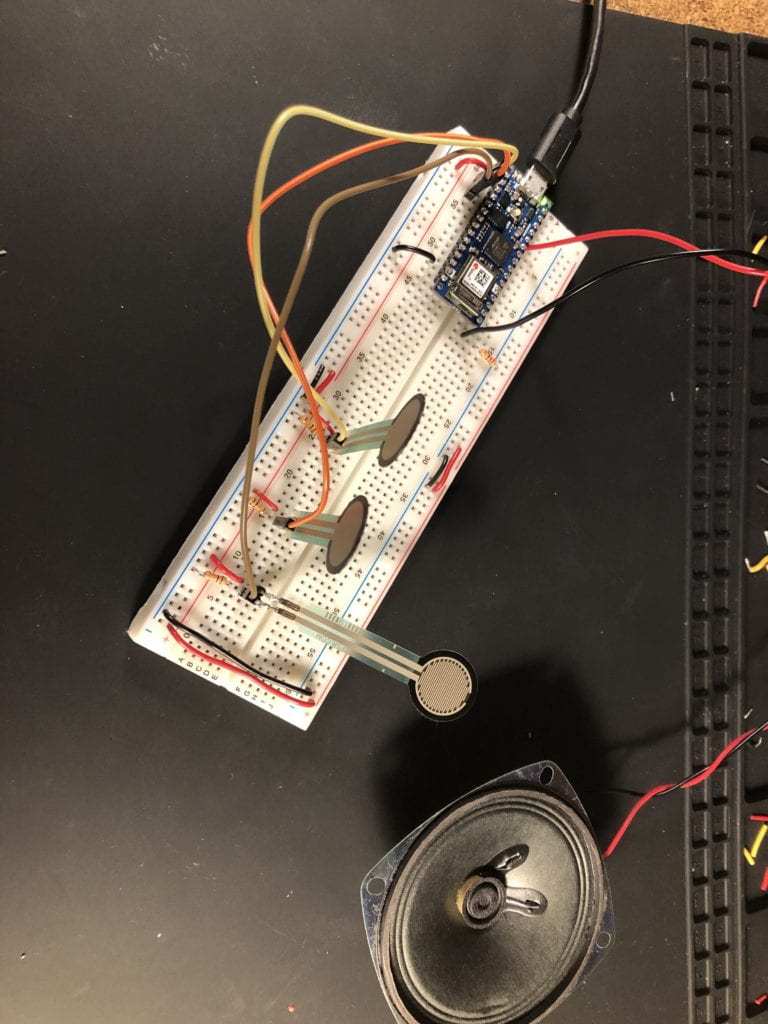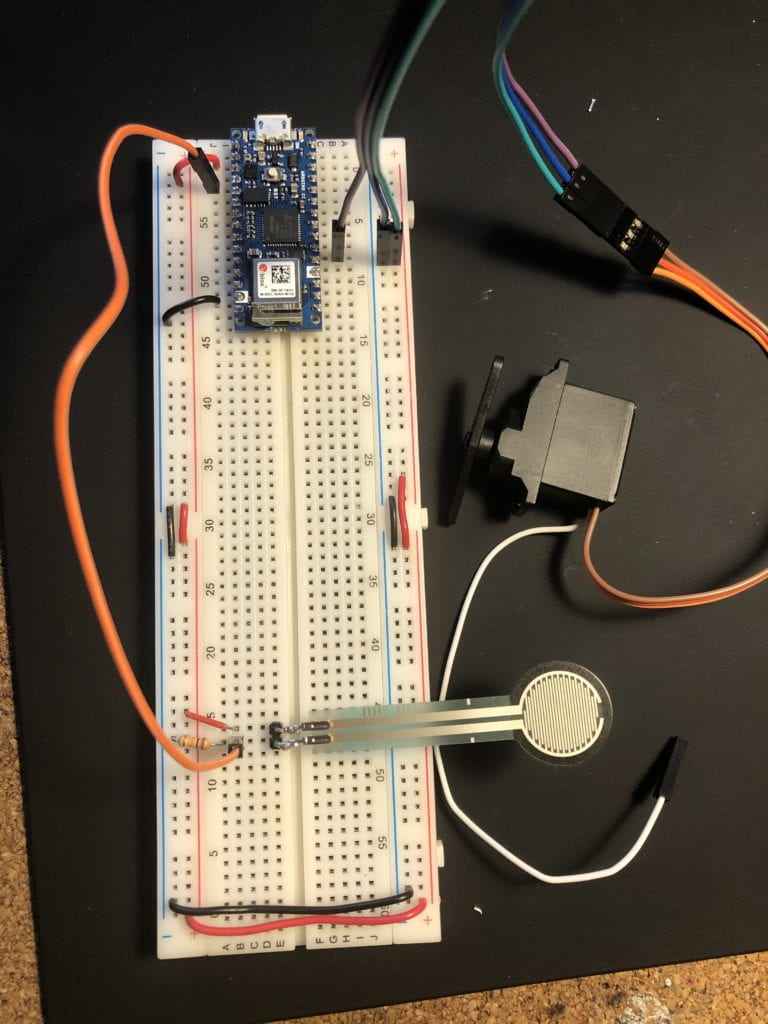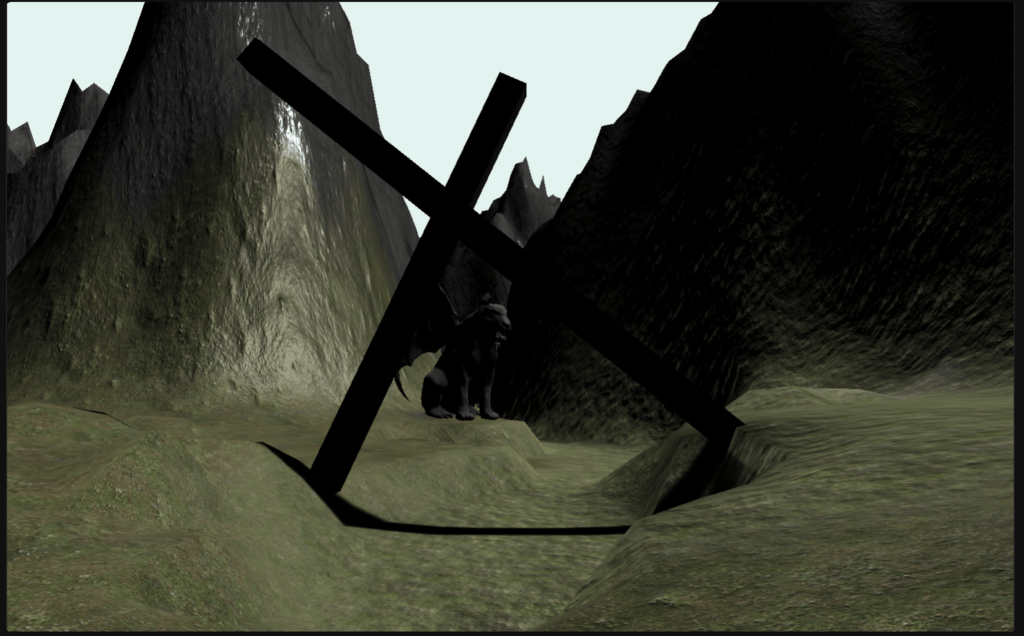
View the piece here in full screen.
Controls: Use the mouse to look around and the arrow or the W, A, S, D, keys to move around the space
Ideation:
I began the project of building a sound walk by considering (1) what is a sound walk exactly and (2) what experience or adventure would I want to explore. Jumping right to the second consideration, I imagined the following: a mediation, a journey through anxiety, an escape through Prospect Park; and an adventure that challenged the user’s perception of their reality. All of which did not quiet fit what I thought to be a valid sound walk. Having never created a sound walk before, I was unsure of the parameters that encapsulate a creating a sound walk. I did, however, find clarification through the blogs of current and former ITP students.
This exploration into past projects provided me with an understanding of what a sound walk could be when kept in our physical reality. I was having trouble imagining what a sound walk would being like when the world it takes place in is open. Since we were given the freedom to create any world within Unity, I needed to rethink what my sound walk would look like. I was a bit overwhelmed by both the scope of the project and by the rush of possibilities that were pouring into my head. I sat with pen and paper to start physically mapping out the desired experience I wanted in this undefined 3D environment. Ultimately, it was time to commit to just one idea and get the project into production.
I decided to create an exploration into memories, a kind of memory garden. The goal of this experience is for the user to stumble upon areas that would bring up some form of memory and to have them sit with what comes up. Each area would have a physical object that correlates with the experience to come once the sound is triggered. These sounds would be based off of those tied to my own experiences. The areas/memory/emotions would be kept to less triggering ones to start with. In future builds, I would design a space called the Briar Patch where more challenging emotions and memories could be confronted. I’d also create a retreat or safe-space within the Briar Patch where the user would have access to comfort and emotion support. The safe-space could potentially have a connection to someone who would be able to provide mental an emotional support for the user. This project could be paired with work currently being done within VR focused around mental health. The primary focus of this preliminary build is to create an interesting and thought provoking exploration into how sounds and memory are connected.
The concept or this project is inspired by my own experiences of memory loss or repression. This project presented an opportunity to explore a way I could both memorialize my experiences and work to bring some memories back.
Build Process:
I started the project build by learning to use a zoom recorder which I took on a long walk through Prospect Park. I was on the hunt for sounds to ill m y sound walk, which I had yet to clearly define. It was, however, a lovely experience to be recording in the park at 7am.
While compiling the recordings, I realized that I needed to get more clear on the concept of this piece. I was luck to have the chance to talk my ideas through with my best friend who helped me to focus in on what I wanted to say. The act of verbalizing the idea provided a lot of clarity. I now had a more focused path, one which took into account my very limited knowledge of and experience with both Adobe Audition and Unity. Next I further mapped out areas within the world as well as any thoughts on their sounds. This part of the build process kept me from going into unnecessary detours for which I am grateful for.
Draft Location Map:
- Welcome with introduction to the space
- Explains: What this is. What to look for. What to beware of.
- Production: Once user starts moving, the background sound will on loop then switch off when the user enters the specific areas.
- Areas:
- Calming (Beach day/pond day)
- Playful (Dogs playing in the park)
- Family (Wind chimes)
- Everyday (Grocery Shopping (Large items))
- Invigorating/night out with friends (Sports event/bar/club)
- Optional/For future build
- Briar Patch (Fox NEWS/Trump, Baby Crying, Metronome/Lessons/Music, Being being asked too many questions all at once)
- Fountain within the Briar Patch (Containing sounds of a stream, connection to support).
Unity:
After mapping out the general layout of where I would want the area to be located, I spent some time getting a refresher on Unity through the recordings from our class session as well as the resident’s help session (thank you Lydia Jessup and August Luhrs!). Once I was in Unity, I created a new project then began figuring everything out. The first challenge I faced was understanding how to look navigate the space. Unfortunately, I was having a much harder time than I expected so it was YouTube to the rescue. Now that I was able to move through the space with some ease, I started to play with creating a floor.
During class we were shown how to create a Terrain, which looked fun and interesting. I wanted to play having the ability to buildup an environment with the swipe of my mouse. Terrain was, however, a bit more challenging. I watched a few videos but each presenter either (a) used a different version of Unity or (b) were trying to do something way too advanced for where I was at. In the end, I experimented with the tools, downloaded lots of terrain assets and I was able to create something that worked. Now that I had the space set and a basic understanding of the tools and presets, I was off to further create my world.
Since I was so interested in the terrain feature, I built a grand mountainous landscape where I could carve out an adventure for my audience. I first created an entry scene where the user would be invited to step down and towards a character thereby triggering the audio. The character, a gargoyle, would then great the user and layout a brief introduction to the space. I was able to use several free assets throughout the walk which will be credited in the final documentation. At one point I considered changing the entire scene as I wasn’t sure this environment was reading as I had hoped for in this experience, but I went with what I had in order to save time. I had to realize that this was the first draft for a piece that I might pursue after this semester was over. For now, the deadline was fast approaching.
Now that I had fully committed to this design, I went for it. I was happy with all that I had created. I decided to get the space setup with all the audio triggers and speakers placed in the world before adding the tracks. This allowed me the ability to fully focus on the to the sound component. All final tweaks would then be done once all the elements were in place and working.
Audition:
I started by seeing what I could use from my trip to Prospect Park with the zoom recorder. Subsequently, I was only able to use a handful of the tracks as my idea had morphed into something completely different since originally recording. I ended up utilizing freesounds.org for most of the tracks (sound credits will be added to the readme file asap as well).
I am grateful to ITP resident Billy Bennet for his sound mixing workshop as it came in handy while editing all the tracks. I particularly found the parametric equalizer effect to be a savior as it was so very helpful in isolating the frequencies that I wanted minimized.
Below is a breakdown in more detail of what went into each area of the sound walk:
Grocery:
Sam Smith’s song, Stay with Me, just happen to have been playing while I was recording in my local grocery store. While editing the track, I realized the mood I was setting as I thought about the lyrics and the design of the physical location within my sound walk. Having ended a relationship recently as well as having just returning to NYC from quarantine with family, buying food for just yourself can seem lonely and invoke a lot of emotion. That sense of loneliness in tandem with Smith’s song created an emotional recording session in the store as well.
The location I created to house the grocery store sounds aims to invoke an overwhelming sense of emotion. The shear size of the grocery items is overpowering. The steep cliff walls are intimating. Overall, there is a sense of being alone and isolated. In another build, I would create this space as a passage way. One where the user could spend time in the loneliness knowing it would pass once choosing to move forward.
Bar/Pool Table:
This area consists of a pool table, two balls and a queue stick which is aligned to hit the ball. Here, the sounds of a subdued tavern play. Listening to the track, I imagine myself sitting in a small town, having a glass of whiskey on a cold day and enjoying my solitude amongst others.
Pond:
Originally I wanted this to be a respite, a place of calm, of undisturbed reflection, featuring the water fall recordings from my trip to Prospect Park. Now that I have the space created and a few of the other tracks analyzed, I had a better idea of the overall theme. I decided to imagine sitting on a dock at a pond, listening to the sounds of a camp on the other side. Is there a longing for the past or one of not having been to a summer camp like that at all or is it a current longing for the chance to be with friends at a pond, being playful and carefree.
Cliff/Wind Chimes:
This area features the sounds of wind chimes and of a creaky porch swing. Both remind me of family. I wanted a space to overlook the water and listen to those sounds over-top of those of the wind. Personally, I would spend time in this particular location of the sound walk. It’s calming and brings up a lot of memories.
Intro/Welcome:
These tracks I recorded and added effects to. I really enjoyed playing around with my voice, which I usually don’t enjoy having recorded. The text runs for about 30 seconds but it hopefully helps to clarify the objective of the piece.
Overall Background Sounds:
I wanted something a little eerie to match the visuals while also being meditative and calming. The background consists of multiple wind tracks under a track containing peaceful repetitive tones.
Name (Anamnesis):
As part of the final recordings, I needed to create a place in which to welcome users to. What was I to call this place I had just created? I played around with various synonyms for memory and came to anamnesis, defined by Webster’s as “a recalling to mind.” This felt right with the grandiose landscape as to which Anamnesis resided.
Reflections:
Thoughts to consider for a future iteration of this piece:
- Test out a variety of worlds. Maybe one that is simpler and less distracting so the focus can be on the memory/emotional work.
- Something more sterile so that the focus can be on the sound.
- A world with more visual queues that relate to the audio and less landscape.
- Possibly a world that looked more like Burning Man. One of mystery and endless possibilities.
- Having a partner to work with would have taken some of the load off as well as opened up more possibilities for what could have been accomplished. I originally had 1 partner then another, both dropped the class. I was also offered the option to join another group but I had already started on the project and chose to go at it alone. This process has been interesting and a struggle on but I do feel grateful for what I’ve accomplished. I look forward to working in a group on the next project.
- Add separate tracks with triggers for footsteps both entering and exiting the various rooms would be interesting. Maybe add footsteps throughout.
- Start the terrain at 0,0,0 so as not to create something on the edge of the world unintentionally. I chose to go with white as the solid color for the sky since I couldn’t move all my items into the center of the terrain at that point.
- Simplify/level out the terrain and use clouds as a way to create space and intimacy (visually I think about all the 90’s movies I remember growing up with that had an “entrance into the pearly gates” scene which would be used as inspiration.)
- Personally, is this piece a memoriam for the places and interactions we’ve lost during COVID? Is this piece possibly a time capsule? This idea could morphed into a way of creating 3D memory boxes.
Questions Regarding the Current Build:
- Throughout the walk, the terrain is bouncing/shacking. What is causing that?
- How do I set the audio triggers/sources to stop playing once the user steps out of the space? Possibly even have the sound fade out as the user moves away.
- Is there a way to have the overall audio (started at the beginning as a loop) to cut out (Fade out) when the sounds are triggered in each room, then have it fade back in once the user leaves?
- What is the proper way to credit your sources in this medium? (Unity free assets and freesounds.org). I can easily pull up the list of tracks/assets used and their corresponding creators but want to place then in line with standard practices.
In conclusion, this is far from perfect but it is a project I put a lot of work into and am happy with the direction it is going.
**There was even a funny outcome; after working in Unity for two and half days straight, I now keep trying to move about the screen using the 3D controls. I end up trying to peer behind the window on my screen.
Unity Assets Attribution:
“Swing” by Nekcom Entertainment
“Food & Grocery Items – Low Poly” by OneCoinGames
“Free Barcade Asset Pack” by Ferocious Industries
“Terrain Textures Pack Free” by ALP8310
“Stylize Water Texture” by LowlyPoly
“Feline Gargoyle” by Sergi Nicolás
“Low Poly Tree Pack” by Broken Vector
Music/Sounds Attribution:
Background Mix:
“Slow Sad Tones.wav” by TJ Mothy is licensed under CC BY 3.0
“Soft Tonal Wind_01” by Jan Bezouska is licensed under CC0 1.0
“Soft Tonal Wind_02” by Jan Bezouska is licensed under CC0 1.0
Pond Mix:
“Canada geese Squawk on a Pod with a Fountain” by Brian W. Smith is licensed under CC BY-NC 3.0.
“Water in a pond” by Jean Thomspon is licensed under CC BY 3.0.
“kid’s summer camp across the pond” by denalwa is licensed under CC0 1.0.
“ile0306_pond_frog_bird_3” by map hill is licensed under CC0 1.0.
Grocery Store Mix:
Recorded sounds at Wholesome Market in Brooklyn, NY by Daniel Ryan Johnston, 2020. Includes incidental music by:
Lynne, Jeff; Napier, James John; Petty, Thomas Earl; Phillips, William Edward; Smith, Samuel Frederick. “Stay with Me”. Copyright. 2014, 1989; EMI April Music INC, Gone Gator Music, Salli Isaak Music Publishing Limited.
“Shopping cart 01.wav” by Sonicorchestra is licensed under CC0 1.0.
Swing Mix:
“Squeak_6.aif” by tim.kahn is licensed under CC BY-NC 3.0.
“Wind-Chimes” by sky dawn a.k.a. Lavender Fields is licensed under CC BY-NC 3.0.
Pool Table/Tavern Mix:
“tavern_Interior_01.wav” by OP-Archive is licensed under CC BY-NC 3.0.
“pool break.wav” by Alastair Cameron CameronMusic is licensed under CC BY 3.0.
